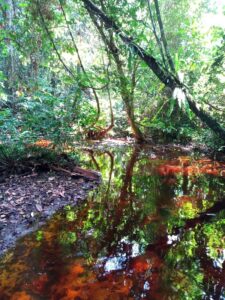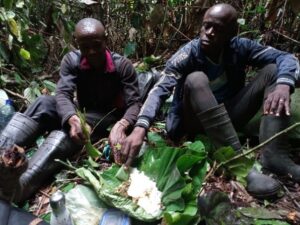A day at a BonDiv site, by Maisie Ettinger
In our camp in the forest of Ikela, 90km south of Basankusu, we usually rise as the sun does, to a breakfast of plantain with coffee and peanut butter (both of which are grown in the village and roasted and hand ground in camp), served up by our cook Papa Ibo who prepared everything over the fire.
With bags loaded with food and water, and any equipment required for the day ahead we set out from camp in twos, a researcher and a pisteur, to which ever part of the forest requires our attention that day. The path out of camp leads directly into the swamps
surrounding the Nkombe River, but log bridges, rubber boots and a conveniently fallen tree over the river, allow us to keep our feet dry. Although, concentration on foot placement is required to avoid sinking into deep mud.

In the forest it is thankfully slightly cooler than in camp, the thick canopy blocking out a good deal of the suns rays, but the humidity rarely falls below 99%.
As Camp BonDiv is located on the southern border of our research zone it can take a few hours to reach our destination if we are working in the furthest reaches of our research zone. Walking always quietly as we can, we are constantly searching for traces of the bonobos as we go, either feeding traces or signs of them walking, and keep our ears peeled for any vocalisations. Whilst we don’t always get bonobos, we often see other wildlife in the forest, various species of monkey, flashes of colourful birds, duikers, the occasional serpent even the odd pangolin. If we have to leave the our transects, to follow bonobos traces, or reach our camera traps, it can take a long time to navigate trough the dense forest, being careful to avoid the various thorns, stinging caterpillars and dangling wasp nests.
Todays mission is to collect samples from the permanent water sources in the forest for isotope analysis so I need to visit three different rivers across our research grid. Making the most of existing paths used by hunters or for caterpillar collection to facilitate quick movement across the forest it takes the best part of a day to reach the three sites where each month we collect the water samples. En route we stop at any camera traps we have previously put in the forest to swap out the batteries and the SD cards for fresh ones.

We eat our lunch in the forest, off of the broad, waxy haumania leaves that are used in construction, to carry food, and cook in, and occasionally fashioned
into to hats if someone forgets their raincoat and gets caught short under a tropical down pour. Once we have refuelled, we head off to the next spot for sample collection, eyes always peeled for signs of bonobos eating or walking on the ground, and for their nests in the canopy.
Back in camp the data collected on smartphones in the forest are downloaded to a laptop and everything is checked; that the data are correct, and all the samples are all labelled correctly and put away for storage until they get taken out of the forest. Then the excitement of checking the camera trap sd cards to see if we have caught any bonobos on video and what else is living around the forest. All the electronics are hooked up to the solar panel system to charge for the next day, as are the large supply of batteries needed to keep the camera traps running at all times.
Daily shower consists of a bucket of water heated over the fire by Papa Ibo, and a scoop, usually as the sun starts to go down. Dinner together as a team under lamplight, with insects buzzing around the light, although thankfully not many mosquitos and with the background soundtrack of the cacophony of insects and occasional bird calls and the odd screech of a galago.
January 2025, By Maisie Ettinger